The Apple iPhone 6s and iPhone 6s Plus Review
by Ryan Smith & Joshua Ho on November 2, 2015 8:00 AM EST- Posted in
- Smartphones
- Apple
- Mobile
- SoCs
- iPhone 6s
- iPhone 6s Plus
System Performance Cont'd
Moving on towards our more GPU-bound workloads, we use our standard test suite of benchmarks like GFXBench and 3DMark to get a good idea for performance. Unfortunately, due to the move to iOS 9 the Unity engine version used in Basemark X is no longer working so for now we’re left with 3DMark and GFXBench. There is also Basemark OS II’s graphics test, but this is embedded in a larger benchmark with CPU and storage performance tests.

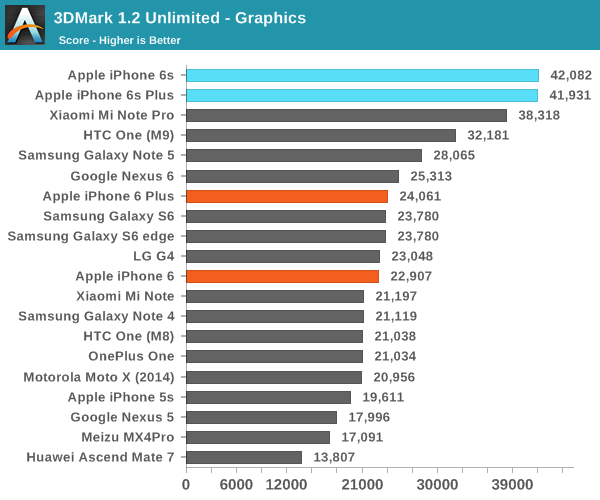
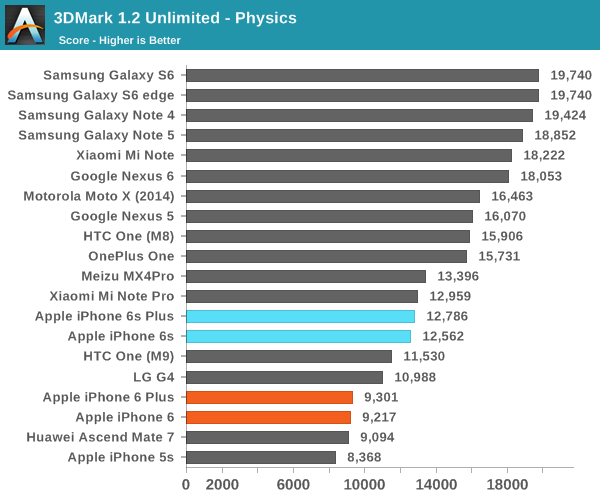
As always with 3DMark, there are some issues in the data structures used. Due to the data dependencies present within the physics test, it is necessary for the CPU to stall for data to be committed to memory before continuing on to the next portion of the test instead of executing instructions in parallel. This strongly reduces the practical performance of the CPU because the architecture is primarily focused upon instruction-level parallelism to deliver major performance gains. However, due to the strong showing in graphics performance the iPhone 6s’ still manage to take the lead.
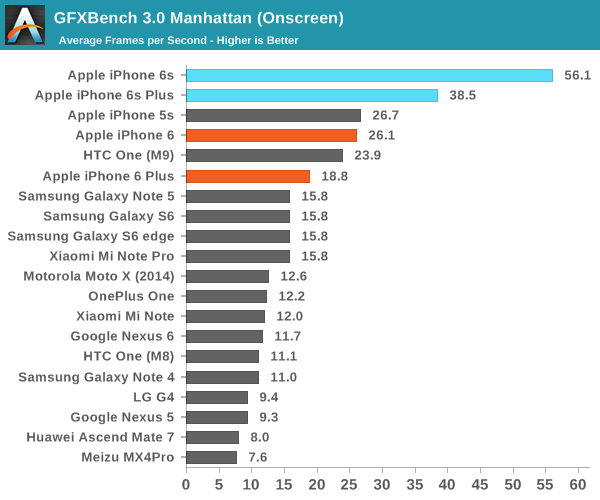
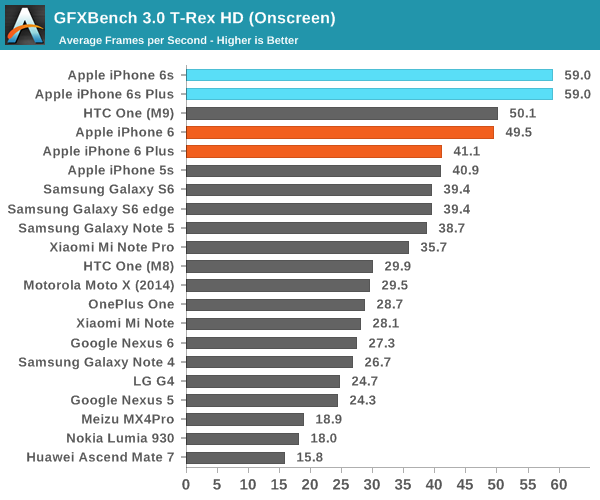
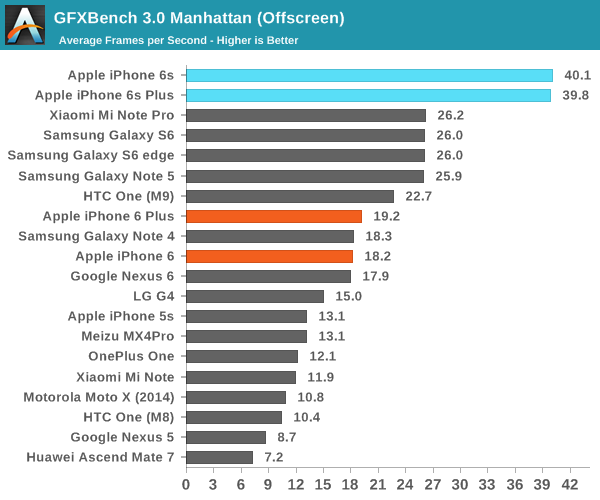

In GFXBench, the A9 SoC just shows absurd performance. It’s strange to think about how the iPad Air 2’s GPU seemed incredibly quick at the time but with the A9 Apple has surpassed that level of performance in their smartphone SoCs. The move to a new generation of PowerVR GPU IP, in addition to the move to a FinFET process node are really the drivers for this kind of performance improvement.
Overall, the Apple A9 SoC is the best SoC in any phone shipping today. In cases like web browsing, gaming, and even just going through the UI it’s quite evident that this new SoC is a major factor in improving performance and smoothness across the board. Something as simple as visiting some popular tech websites will show this, which really goes to show how much “specs” still matter due to their influence on user experience.
NAND Performance
At this point is almost goes without saying that storage performance is important, but in a lot of ways the testing here is still in its early days. In the case of the iPhone 6s we’ve discussed what distinguishes its storage solution from others in this industry, but for those that are unaware the iPhone 6s uses PCIe and NVMe instead of a UFS or eMMC storage solution. In a lot of ways, this makes the storage on board closer to the SSD that you might find in a more expensive PC but due to PCB limitations you won’t necessarily see the enormous parallelism that you might expect from a true SSD. In the time since the initial results we've found that all of our review units use Hynix-supplied NAND. In order to test how this storage solution performs, we use Eric Patno’s storage test which allows for a simple storage test comparable to AndroBench 3.6.
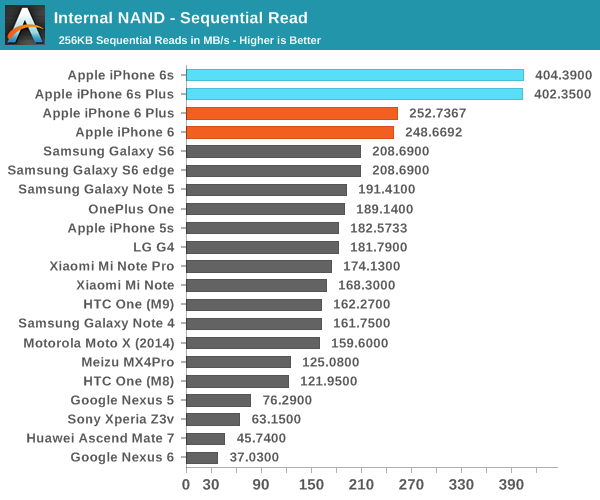
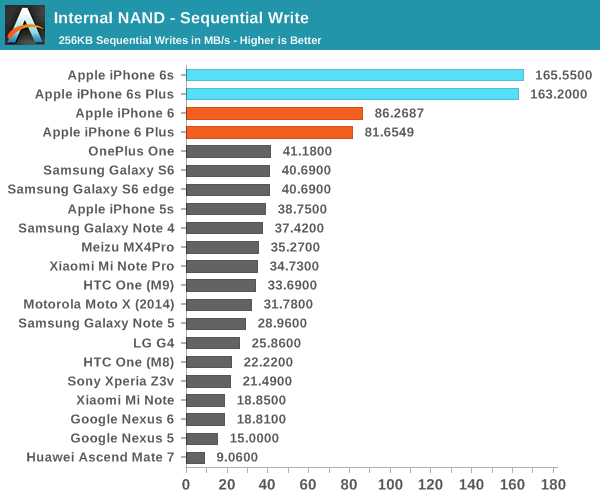
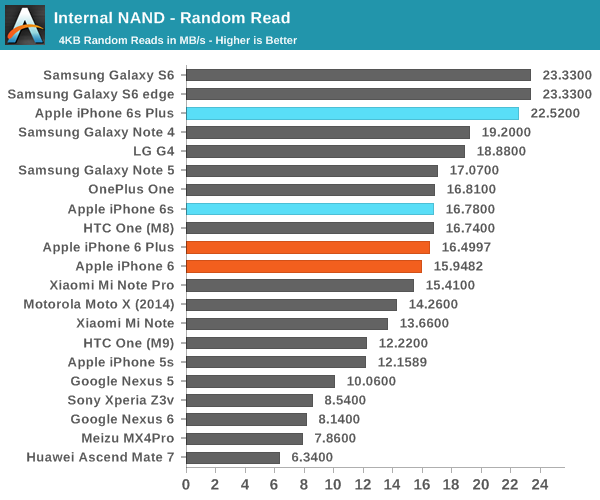
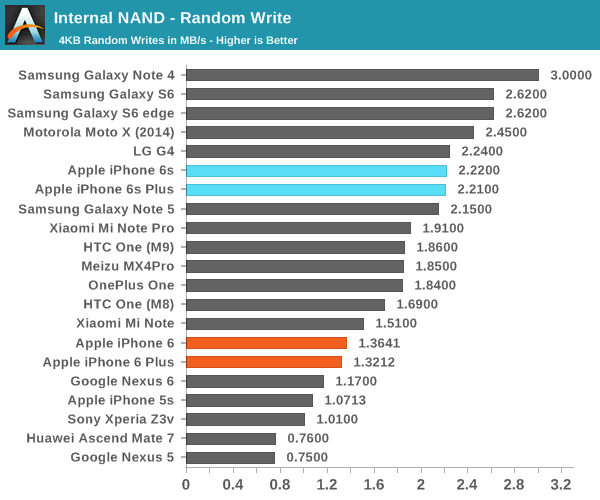
Here, we can really see the enormous performance improvements that result from a combination of TLC NAND with an SLC cache, along with the new NVMe protocol which allows for low CPU overhead and removes architectural bottlenecks to storage performance. This should allow for things like faster burst photos and faster app updates. Downloading and updating apps on the iPhone 6s feels noticeably faster than it is on the iPhone 6, to the extent that small apps feel like they install almost instantly when I’m on a WiFi connection fast enough to saturate storage bandwidth.










531 Comments
View All Comments
tipoo - Monday, November 2, 2015 - link
I still don't fully understand the performance degradation chart, wouldn't it make more sense to divide the final FPS by the first FPS to see how much it degraded? Device 1 has performance of 100, degrades to 40, device 2 has performance of 60, degrades to 35, device 2 degraded by a smaller percent but still shows lower in the chart because of it's internal performance.Brandon Chester - Monday, November 2, 2015 - link
All of these devices throttle down pretty quickly and in most cases that final framerate will be indicative of the performance a user would have seen for the bulk of a time playing a game with that same level of visual quality. It's basically meant to be an indicator of what performance you'd really end up seeing for a prolonged gaming session, rather than a change from peak to typical performance.tipoo - Monday, November 2, 2015 - link
I see what you mean, thanks.Brandon Chester - Monday, November 2, 2015 - link
I agree that the chart name is terrible. I'll see if we can change it to make more sense.Xell123 - Monday, November 2, 2015 - link
"Sustained Performance"?Xell123 - Monday, November 2, 2015 - link
Relative degradation (1-) (sustained/burst) is also interesting btw. so you could do 2 diagrams or combine the data. :)tipoo - Monday, November 2, 2015 - link
My 6S doesn't do too well in barely dim light. I think 12MP for the same sensor size was a bit of a stretch - maybe 10 would be a happy medium, or just go to the next size up. It gets grainy really fast. Some tests show it worse than the 6 in dim light, but better in daylight.Der2 - Monday, November 2, 2015 - link
I was expecting apple to go a measely 10MP so they could kinda maintain that high micron pixel count and whatnot. At least, 8.3mp was needed for 4K recording capability.Brandon Chester - Monday, November 2, 2015 - link
No, they need more than 8.3MP to get 4K, it's not a 16:9 sensor. You actually need the 12MP to be able to do EIS, because the horizontal axis is still only 4032 pixels.zeeBomb - Monday, November 2, 2015 - link
Ohhhh that's right. Totally got blindsided and forgetting it isn't 4:3. My bad!